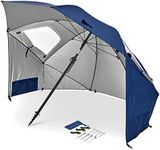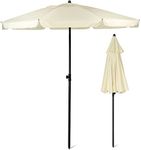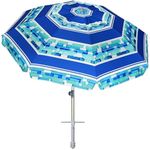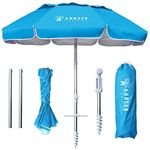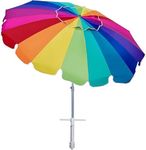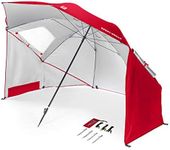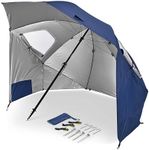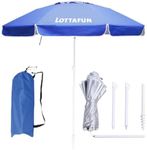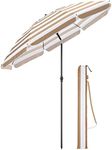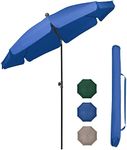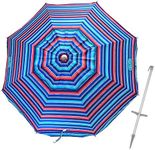Buying Guide for the Best Beach Umbrellas
Choosing the right beach umbrella can make your day at the beach much more enjoyable. A good beach umbrella will provide ample shade, be easy to set up, and withstand the elements. When selecting a beach umbrella, consider the following key specifications to ensure you pick the best fit for your needs.SizeThe size of a beach umbrella is crucial as it determines how much shade it can provide. Beach umbrellas typically range from 5 to 9 feet in diameter. Smaller umbrellas (5-6 feet) are more portable and easier to handle, making them ideal for solo beachgoers or couples. Medium-sized umbrellas (6-7 feet) offer a balance between portability and shade, suitable for small families. Larger umbrellas (8-9 feet) provide extensive shade, perfect for larger groups or families but can be heavier and more cumbersome to transport. Consider how many people will be using the umbrella and how much shade you need.
MaterialThe material of the umbrella canopy affects its durability and UV protection. Common materials include polyester, nylon, and canvas. Polyester is lightweight, water-resistant, and offers good UV protection, making it a popular choice. Nylon is also lightweight and quick-drying but may not be as durable as polyester. Canvas is heavier and more durable, providing excellent UV protection, but it can be harder to carry. Choose a material based on your need for UV protection, durability, and ease of transport.
UV ProtectionUV protection is a critical feature for a beach umbrella, as it shields you from harmful ultraviolet rays. Look for umbrellas with a high UPF (Ultraviolet Protection Factor) rating, typically ranging from 30 to 50+. A UPF rating of 30 means the fabric blocks about 97% of UV rays, while a rating of 50+ blocks about 98%. Higher UPF ratings offer better protection, which is essential if you plan to spend extended periods in the sun. Consider your skin sensitivity and the amount of time you will be exposed to direct sunlight when choosing the UPF rating.
StabilityStability is important to ensure your beach umbrella stays in place, even on windy days. Features that enhance stability include a sturdy pole, a pointed or screw-like base for anchoring in the sand, and wind vents in the canopy. Poles made of aluminum or steel are strong and durable, while fiberglass ribs can provide additional flexibility and wind resistance. Wind vents allow air to pass through the canopy, reducing the risk of the umbrella being blown away. If you frequent windy beaches, prioritize stability features to keep your umbrella secure.
PortabilityPortability refers to how easy it is to carry and transport the beach umbrella. Consider the weight, whether it comes with a carrying bag, and if it has a compact design. Lightweight umbrellas (under 5 pounds) are easier to carry but may compromise on size and stability. Heavier umbrellas (over 5 pounds) offer more durability and stability but can be more challenging to transport. A carrying bag with a shoulder strap can make it easier to carry the umbrella over long distances. Think about how far you need to carry the umbrella and your ability to handle its weight when considering portability.
AdjustabilityAdjustability features allow you to tilt or rotate the umbrella to block the sun as it moves across the sky. This can be particularly useful for maintaining shade throughout the day without having to reposition the entire umbrella. Look for umbrellas with a tilting mechanism or adjustable height. These features add convenience and ensure you can stay protected from the sun at different times of the day. If you plan to spend long hours at the beach, adjustability can enhance your comfort and sun protection.
